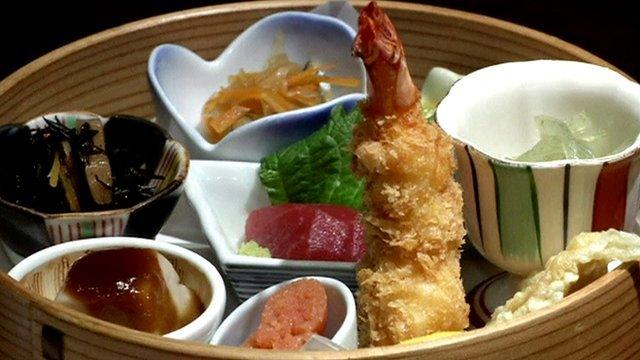Taiwan seeks recipe for success for its cuisine
- Published
BBC's Cindy Sui finds out what makes Din Tai Fung dumplings so special
Surrounded by the sea, Mother Nature has blessed Taiwan with an abundance of marine life. And with plenty of farms located near cities, there's always a ready supply of fresh ingredients for your next meal.
But ask any outsider about their knowledge of Taiwan's food, and you are likely to get a perplexed look, unlike its neighbours Japan and Korea, whose cuisines have very distinct identities.

Din Tai Fung's pork dumplings are a favourite with locals and tourists
Other than bubble tea, few culinary inventions from Taiwan have gained fame beyond its borders, while the island only has one internationally-known food brand - dumpling maker Din Tai Fung.
Now, Taiwan wants to raise the profile of its little-known cuisine, hoping to be known for more than just making many of the world's high-tech gadgets.
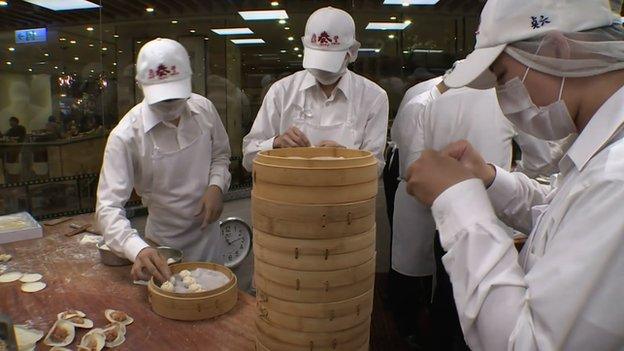
A lot of care and precision go into the preparation of the pork dumplings
To this end, the island has been organising the annual Taiwan Culinary Exhibition at home, as well as roadshows abroad. Such efforts have brought in more tourists and given a boost to Taiwan's food and beverage industry, valued at $14bn (£9bn) in 2014.
But despite government assistance to help restaurants expand overseas and build a name for Taiwanese cuisine, not many have succeeded.
Dumpling jackpot
So far, only Din Tai Fung has managed to break out. The dumpling chain has opened 112 restaurants in 11 destinations around the world, from Sydney and Singapore to far-flung Seattle in the US.
But its success may not be easily duplicated. Its fame stems from a strong focus on quality, and some luck.
Din Tai Fung started selling its juicy minced pork dumplings in the 1980s and they proved immensely popular with the locals. But they were unknown worldwide until 1993, when the New York Times listed the restaurant as one of the world's top 10. Further recognition followed - fans now include Hollywood celebrities and and it's the only food brand in Taiwan that has earned a Michelin star.

Taiwan's immigrant population plays a big part in its cuisine
But others are struggling to match such success. Restaurant chain Shin Yeh has found it hard to expand overseas, as experts say its dishes - more complicated than Din Tai Fung's dumplings - are harder to duplicate abroad without exporting top chefs.
But perhaps the main reason is simply that people overseas are unfamiliar with Taiwanese food.
Some say even the Taiwanese themselves are not sure what constitutes Taiwanese food, and which dishes should take centre stage.
Culinary identity?
"Only since 2000, when the Taiwanese sense of identity became stronger, did we start to wonder what Taiwanese food is - what can we present in terms of food that represents Taiwan?" says May Chang, chief executive of the Foundation of Chinese Dietary Culture, which promotes Taiwan's cuisine.
Taiwan's population is made up of immigrants, a majority from mainland China, so many if its recipes originate from there. The island was also a Japanese colony for 50 years, which explains the influence of flavours still present in some dishes to this day.
Ms Chang says it's hard to find one type of food to represent Taiwan.
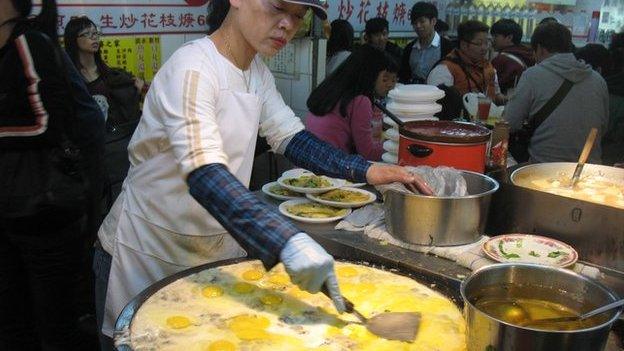
Oyster omelette, while popular at Taiwan's night market, is also available in China and Singapore
"A lot of our food comes from China," she says. "For instance, oyster omelettes can also be found in China's Fujian province, so can beef noodle soup, even though we say ours is more tasty. And we have different ethnic groups who came from different parts of China, so it's sensitive - we can't just choose one group's food over another's to represent Taiwanese cuisine."
The Taiwanese feel so strongly about having an identity of their own, including their own food, that a heated debate arose a few years ago - after an international publication claimed that the popular local dish "braised pork rice" originated from mainland China. Many on the island argued that it was purely Taiwanese.
But Taiwan does have unique flavours to its cuisine, which becomes immediately obvious during a visit to any night market. Some of the food may have originated from China or been influenced by other countries, but it has been re-invented by the Taiwanese.
Examples include "small sausage in big sausage" (a pork sausage topped with pickled fillings stuffed in an open, bigger rice sausage), "sesame oil chicken" (chicken stewed in sesame oil and rice wine), "coffin bread" (a thick toast filled with a seafood soup), and "san su" (stir-fried fern with anchovies).
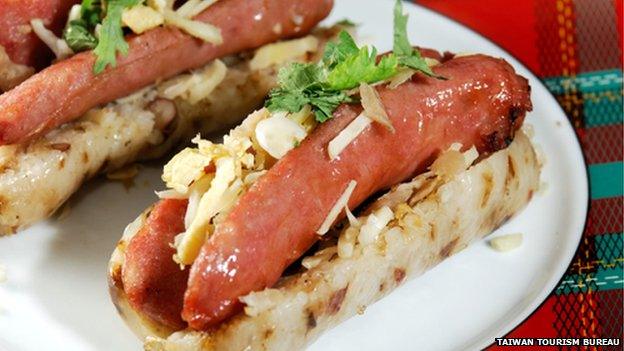
Modified, re-invented recipes are a common sight at Taiwan's night markets
Indigenous cuisine
The fern dish is one from Taiwan's indigenous tribes, another favourite being fish cooked using heated stones. Much of the tribes' cuisine is distinctive and not commonly seen, but this could soon change.
The cuisine of Taiwan's indigenous people is increasingly being valued. In the past, they didn't have the ability to promote their own food because of the high costs, so it was mainly tasted by Taiwanese people on sightseeing trips to the tribal areas. But now there are companies providing funding to set up restaurants that hire indigenous people to work as cooks.
They're also opening their own restaurants, like Daluan Restaurant, owned by a member of the Amis tribe, external.
Hsia Hui-wen, founder of Taiwan Chefs Federation, says the government should do more to promote Taiwan's food.
"We have to let people know our food is distinctive - it's made in a healthier way than Chinese cuisine, with less heavy sauces, and includes flavours from immigrants," he says.
He argues the island's cuisine is becoming better known. "Taiwanese cuisine was previously not even considered a type of Chinese cuisine (like Sichuanese or Cantonese cuisine), but now there is such a category," Mr. Hsia said. "And in many countries' Chinatowns, you can see Taiwanese restaurants (unlike in the past when you would only see Chinese restaurants)… it's become a brand," he said.
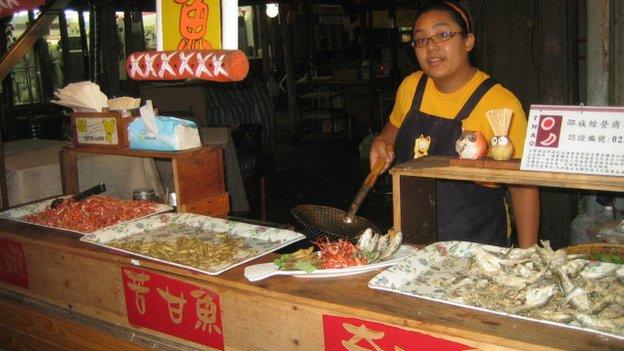
Taiwan's indigenous cuisine is also available at certain night markets
Building a brand
Some wonder whether it matters that Taiwan's food comes from elsewhere. The point is being proud of it.
While some young chefs at Taipei's Kai Ping Culinary School say they are more interested in opening Japanese or other restaurants after graduating, because they think it's more profitable, others are aspiring to represent Taiwan's food on the global stage.
"What we need to do is make our food stand out, such as by using more local ingredients, and innovating new flavours that no one else has but everybody loves," says student chef Shao Chi-han.
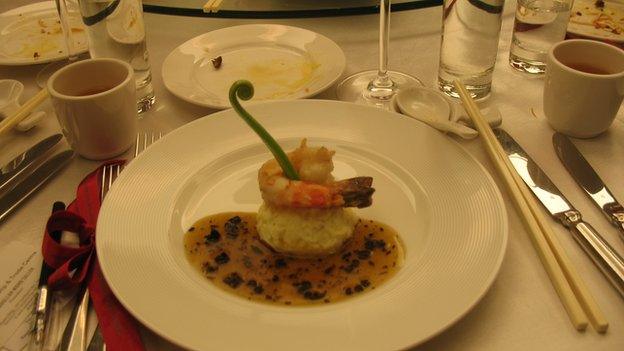
Taiwan's younger chefs are keen to mix local produce with modern cooking techniques
There's an increasing trend to do just that - combining different flavours and cooking styles of Taiwan's indigenous and ethnic groups as well as other countries, using local ingredients and presenting it in a new way. This can be seen in an increasing number of restaurants, including at top hotels.
But for now, Din Tai Fung is an exception and a lesson: If Taiwan wants more of its cuisine to win over palettes around the world, not only will it have to make its food taste great, but ensure it becomes a well recognised brand, just like the famous little dumplings.
- Published26 May 2015

- Published19 June 2014

- Published5 December 2013
